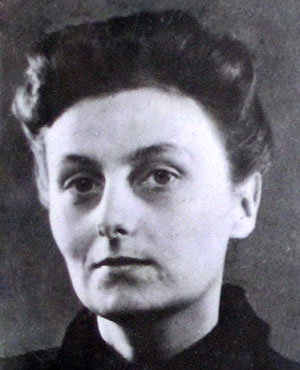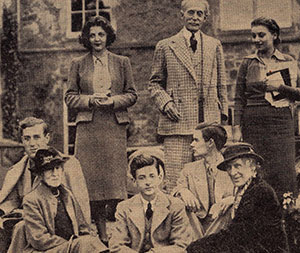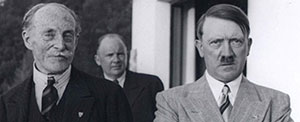Holocaust denial, treason and Irish identity
Published in Features, Issue 6 (November/December 2017), Volume 25Róisín Ni Mhéara—it is important to remember that she was not what she seemed.
By Mark M. Hull

Above: Phyllis Ursula James, alias Rosaleen James, Nora O’Mara, Rosaleen O’Mara, Roisin O’Mara, Róisín Ni Mhéara and Róisín Ni Mhéara-Vinard. (Mark Hull)
When the Irish-language book Cé hí seo amuigh? appeared in 1991 it created momentary excitement, though the discussion was confined largely to the Irish-language press. The author was Róisín Ni Mhéara, an Irishwoman who had lived through the trauma of the Second World War in Germany and had a unique story to tell. Raised among the British aristocracy, she had been working in Austria when war broke out and immediately took the opportunity to strike back at Ireland’s traditional enemy, the British, in any way she could. Róisín volunteered to tell her truth as a commentator on Nazi radio and worked tirelessly to educate the Germans about the reality of post-colonial Ireland, seeking to build cultural bridges between these two peoples, united in their hostility to rapacious Britannia. Hitler well understood these things but his mission to save German culture was frustrated by outsiders in a war he did not want. Indeed, according to Ni Mhéara there is hidden truth to the so-called Holocaust.
Almost all of this is a lie, but it is a carefully manicured lie that the author promoted for almost 70 years and one which was accepted by many who should have known better. Some of them did know better and simply did not care. In fact, she was English, and an English traitor at that. Her real name was Phyllis James, although she went by many pseudonyms over the years: Rosaleen James, Nora O’Mara, Rosaleen O’Mara, before settling on the final incarnation, Róisín Ni Mhéara (or Róisín Ni Mhéara-Vinard). By trial and error, and with deliberate intent, she morphed from an abandoned English infant to fully Gaelicised, ethnic Irishwoman during a decades-long strategic campaign to become something she was certainly not—Irish.
Two versions of her life story

Above: Sir Ian Hamilton (standing, centre) with his extended family in 1938. James (standing, left) claimed to have been adopted by the Hamiltons. A later MI5 report stated that she was possibly Sir Ian’s ‘natural’ (illegitimate) daughter. (Liddell Hart Centre for Military Archives, King’s College, London)
James’s life story has two versions: the one she manufactured and perpetuated, and the one exposed by the documentary record. Although these two occasionally intersect, the differences are striking and significant. To cite only one instance out of many, she claimed to have been adopted by Sir Ian and Lady Jean Hamilton, her Irish father having been killed in the First World War (at the behest of the British) and her mother unable to care for her. James’s birth certificate tells quite another story. Her mother was a lady’s maid in London—close by the Hamiltons’ London residence at Hyde Park Gardens—and her father was unnamed, although Lady Hamilton’s diary reports that he was committed to a mental institution. A later MI5 report stated that James was possibly the ‘natural’ (illegitimate) daughter of Sir Ian. The entire episode lingers under a cloud and it remains unclear whether James was adopted, fostered or taken in by the Hamiltons through an extra-legal arrangement, although this last possibility seems most likely. The somewhat elderly Lady Hamilton wanted company in what was otherwise a childless marriage, although her connection with young Phyllis (nicknamed Rosaleen) and another adopted child, Harry Knight, was oddly distant and prone to disappointment. Whereas Harry grew up and fulfilled his filial expectations, even going into the army with Hamilton’s old regiment, Phyllis/Rosaleen did not. Despite being raised by one of the most prominent families in England, she was never formally presented in society—a peculiar turn of events in itself—and instead developed a fascination with the theatre. Rosaleen spent a year at a girl’s boarding school in Germany and bided her time until she could escape. During the 1930s, as a teenager, she made one tourist visit to Ireland that lasted just under a week and which would be the basis for her decades-long fraud.

Above: Sir Ian Hamilton with Adolf Hitler at the Berghof on the Obersalzberg on 7 August 1938. Hamilton was a tireless advocate of rapprochement with Germany and a prime mover in the Anglo-German Friendship Society. (Liddell Hart Centre for Military Archives, King’s College, London)
During the 1930s, Sir Ian Hamilton was a tireless advocate of rapprochement with Germany and a prime mover in the Anglo-German Friendship Society. Even after the point where naivety was replaced by appeasement, he continued to insist that Adolf Hitler was more committed to peace than was the Chamberlain government. The apogee of his support was an invitation from Hitler to visit him at the Berghof on the Obersalzberg, an invitation that Hamilton gratefully accepted. The two First World War veterans talked about improved relations between their countries and later Hitler dispatched his personal aircraft to return Hamilton to England. Hamilton’s reputation, still marred by his failure at Gallipoli in 1915, never recovered.
In 1937 Rosaleen James went to study acting in Vienna, although without a firm plan. This frustrated Sir Ian, who chided her on the aimless (and expensive) sojourn in which she auditioned unsuccessfully for parts, took the occasional class and waited for success. Consequently, she was in Austria for the Anschluss, the incorporation of Austria into the Third Reich. In her later autobiography, she mentioned her admiration for what Hitler accomplished and for the comeuppance meted out to one particular group:
‘As regards the city of Vienna, this powerful minority now had to pay for the dissatisfaction of the people. That is how, on occasion, the citizens took their spite out on the Jews on the spur of a moment, and those Jews who went into hiding rather than take a seat on a train usually did not succeed well.’
This was not the last time she would comment on the subject of the Jews, Hitler and the Holocaust.
Sinne mar Éireannaigh
Her autobiography has several purposes, one of which is to convince the Irish reader that she is one of them. To this end, she uses ad nauseam the refrain sinne mar Éireannaigh (we Irish). Her evolving relationship to Nazi Germany is explained in this way: Britain is the historic enemy of her Irish people, and as a patriotic Irishwoman she could not do otherwise than support the enemy of her enemy. Accordingly, when war broke out, and with no desire to return to life in England, James began the first of her many name and identity changes. She travelled to Germany and volunteered her services to the Nazi radio propaganda apparatus, although there is no record of her appearing as on-air talent prior to 1941, and even then only in a minor role. This position was due to the assistance of Irish ex-patriate Francis Stuart, who had found a home at the Irish Service of the Propaganda Ministry. Stuart and James had an on-again, off-again relationship until he met his future second wife, Madelaine Meissner, and James became pregnant by a Ukrainian (or Russian) whose name was never revealed.

Above: James’s most interesting contact in Nazi Germany was John P. O’Reilly, a former potato-picker on Jersey who, through guile and bluster, worked his way up the collaboration ladder (see HI 14.1, Jan./Feb. 2006, pp 36–41). He was later parachuted into Ireland, arrested, escaped and was eventually turned in by his father for the £500 reward. (Irish Military Archives)
Even before this, her treason continued apace. Although a British subject and holding a British passport, James presented herself as ethnic Irish when she approached or was approached by German military intelligence (Abwehr) in 1940. Abwehr officer Kurt Haller put her on retainer and asked that she help prepare agent Hermann Görtz for his mission to Ireland. Since her only contact with the island consisted of that brief visit in the 1930s, much of what she passed along was pure invention and she mainly helped Görtz to practise his English. Later, and while still working with the Abwehr, she went along with Francis Stuart and Frank Ryan to the Friesack Stalag in an attempt to recruit Irish prisoners for use against Britain by German intelligence. Perhaps her most interesting contact was with John P. O’Reilly, a former potato-picker on Jersey who, largely by guile and bluster, had climbed the collaboration ladder in the German intelligence administration and had worked for the radio propaganda service, German military intelligence and finally the SS intelligence service (the SD). James and O’Reilly did not get along—largely, it seems, because as an authentic Irish person O’Reilly could expose her carefully crafted identity. His return to Ireland via an SD parachute in 1943 removed James’s immediate danger, but her own usefulness had come to an end and she seems to have spent the remainder of the war trying unsuccessfully to find stage work. In a still unexplained episode, she received a 400 Reichsmark gift in 1944 on the personal authorisation of Joseph Goebbels for an unspecified ‘act of merit’.
Exit from Berlin
Her exit from Berlin in 1945 offers another tantalising possibility. At the end of April, as the Russians closed the noose around the Führerbunker, SS-Gruppenführer Hermann Fegelein—Himmler’s representative—was discovered missing. When he was arrested at his apartment (in civilian clothes, preparing for a quick exit) he was in the company of an actress said by the bunker survivors to be a woman claiming to be Irish who spoke a few languages passably, one of which was Hungarian. Phyllis James had studied Hungarian while in Vienna. Since at least 1941 she had been on a list of ‘Renegades’ prepared by British intelligence (MI5) of collaborators in Nazi Germany. These people were to be arrested if discovered by Allied forces, interrogated, and referred for prosecution under the Treason Act. Traitors John Amery and William ‘Lord Haw Haw’ Joyce followed this path to perdition. When James suddenly appeared in Paris in June 1945 she was taken into custody and questioned. Despite what appears to be irrefutable evidence of her guilt, a series of messages from London ended the interrogations, stipulated that she would be allowed to return to England and ordered her investigative file closed and destroyed. But for document copies concerning her that were distributed to other ongoing investigations, it would have been impossible to reconstruct what she did and what British intelligence could prove. Quite a lot, it turns out.
James never did return to England. She had been disinherited by Lady Hamilton prior to her death and was not mentioned at all in Sir Ian Hamilton’s will (although another ‘natural’ child appears to be). She took a few parts in local theatre productions in Germany but journeyed to Ireland in 1946. She took language lessons, and set about filling out her Irish persona portfolio. This eventually led to founding an Irish cultural museum on Inis Mean, a short-lived puppet troupe designed to teach Irish to children, and then finally to close association with Irish-language groups and politics. She became friendly with the archbishop of Armagh, Cardinal Tomás Ó Fiaich. For unclear reasons, James (now styling herself Róisín Ni Mhéara after briefly experimenting with Roisin O’Mara, a version of her wartime pseudonym on Nazi radio) moved to Bernau, Germany, and to Austria. For several years she wrote a ‘Letters from Europe’ column for the Irish-language publication Innui, and her writing was an early indication of what came a bit later: establishing her Irish bona fides, criticism of modernism, promotion of conservative Catholic theology, and praise for pre-war and wartime Germany, the Germans and the Germanic spirit.
Cé hí seo amuigh?

Above: The cover of Cé hí seo amuigh? (Coisceim, 1991) by Róisín Ni Mhéara. Who indeed?
The culminating event was the 1991 publication of Cé hí seo amuigh? [‘Who is she outside?’]. It is a curious book that purports to be James’s (as Ni Mhéara) autobiography from her childhood (Irish child taken in by English adoptive parents) through her struggle on behalf of the Irish through the trials and tribulations of an English-inspired war against her adopted Aryan homeland. It is filled with scenes of German fortitude, English perfidy and Gaelic nobility. It is also singularly false and repugnant. James’s most odious comments are those instances where she discusses the Holocaust—according to her information, a myth created by Allied propaganda.
In many places, she sets the reader up for the final act of Holocaust denial. Speaking of the period before the war, she offered that
‘Whatever happened after that, it is impossible to deny that Germany was seriously looking for a permanent sanctuary for the Jews … it always fell on them to find a practicable way for a re-settlement program of the same type when the large number of other Jews were taken by the German army at the mobilisation of the ample regions of the East. That army could do nothing but to gather the Jews, by their own admission their fierce enemies, into ghettoes, postponing a solution for the problem of that class until after the war. And there are plenty of documents in evidence of this good plan.’
Drawing on her faux-Irish identity, she continued:
‘At the end of the day, it is right for us Irish to observe from the sidelines … there is plenty of evidence that the Germans did their serious best to solve the “Jewish problem” humanely. It cannot be denied either that the other nations put obstacles in the way of that sort of thing. Since secret documents of great import are still under lock and key by the authorities ruling now, we cannot pass judgement, or fault people. There are two sides to a leaf—or to a boat, as said in Connemara!’
Her views on the facts of the Holocaust were summed up in a passage where she claimed inside information from a nameless cook who once worked in either Buchenwald or Bergen-Belsen (she was not sure which). Photos of corpses merely showed ‘internees’ who had been transported from the East for their safety, but because of Allied air raids that destroyed German rail infrastructure the normal three-day trip took three weeks. Some of the internees, unfortunately, died en route and the Allies then advanced a fake story about extermination. In addition, she quotes an unnamed American GI who she says was ordered to photograph disinterred German civilian corpses from Dresden, which were then falsely identified as concentration camp victims.
While most reviewers keyed in on her pro-Nazi stance, others were more sympathetic and praised her skilful use of Irish and valuable contribution to the history of the Second World War. When asked by an interviewer whether she really believed that the Holocaust was just a fiction, as she had written, her response was unambiguous: ‘I don’t believe it is right to condemn people (Germans) who did not have the opportunity to defend themselves. There are always two sides to every story.’ She did not try to walk the statements back or modify them in any way. Oddly, her pro-Nazi, anti-Semitic views did not cost her friends in Ireland or abroad. Her publisher received an Irish state grant (which was standard for any book written in Irish, regardless of content), and she continued to write and to lead Irish pilgrimage tours to sites associated with saints; she was welcome in Armagh any time she wished, and no one ever questioned her entirely fake Irish identity. All was quickly forgiven and forgotten.
Phyllis Ursula James died in 2013, unrepentant of her own past or the actions of Hitler’s Germany.
Mark M. Hull is a professor at the US Army Command and General Staff College, Fort Leavenworth, Kansas, and is a Fellow of the Royal Historical Society.
FURTHER READING
G. Elborn, Francis Stuart, a life (Dublin, 1990)
M. Hull, Irish secrets: German espionage in wartime Ireland (Dublin, 2003)
M. Hull & V. Moynes, Masquerade: treason, the Holocaust, and an Irish imposter (Norman, 2017)
I. Kershaw, Making friends with Hitler (London, 2004).


















